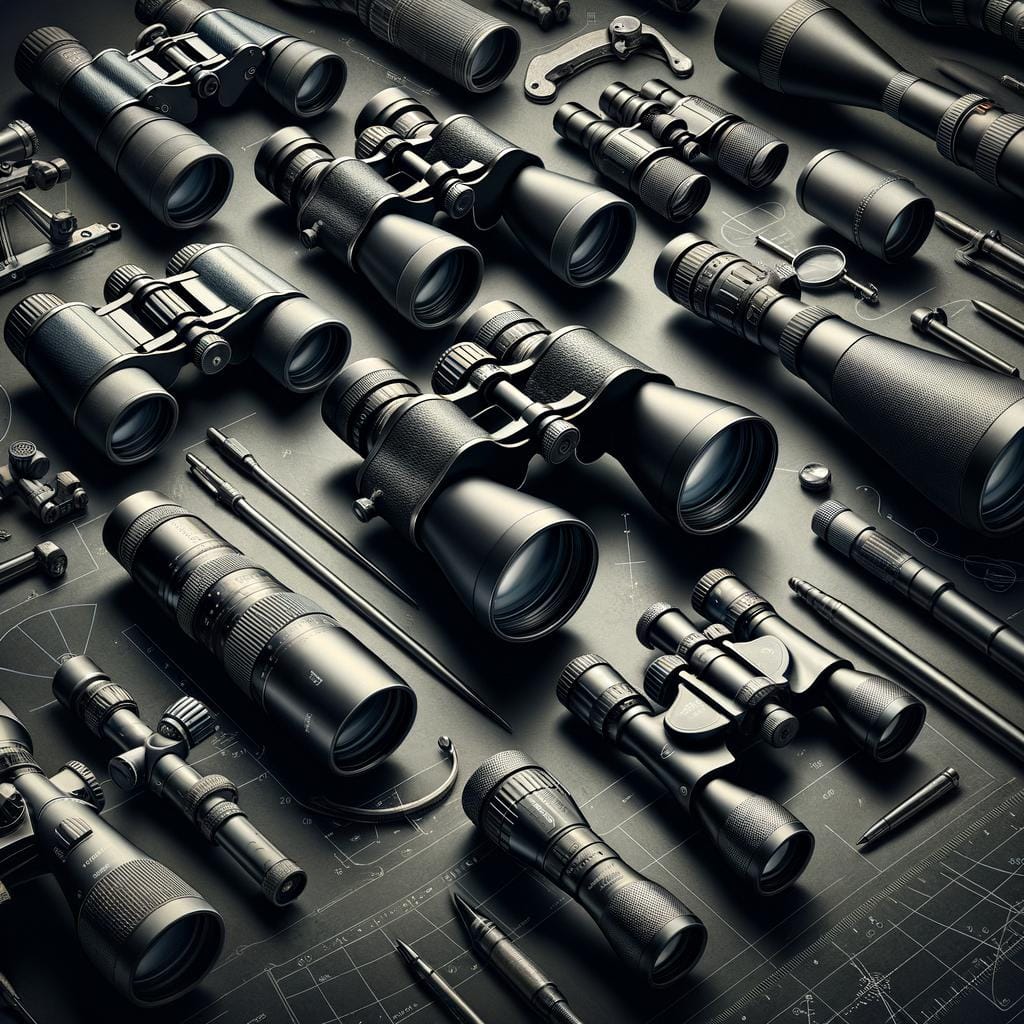Binoculars and scopes serve as essential tools for exploring the world around us, offering a closer look at objects near and far. Whether you are an avid bird watcher, an astronomer studying the cosmos, or a hunter tracking game, having the right optics can make all the difference in your viewing experience. These devices enhance our ability to observe details that may be missed by the naked eye, providing a new perspective on the beauty and intricacies of our surroundings.
The history of binoculars dates back to their invention by renowned scientist Galileo in the early 17th century, paving the way for advancements in modern optics. Over the years, these optical instruments have undergone significant developments in design and technology, leading to a wide range of options available today. From compact binoculars ideal for on-the-go use to high-powered scopes for precision viewing, there is a vast selection to suit various needs and preferences.
Understanding the different types of binoculars is crucial in determining which model best suits your intended use. Factors such as magnification power, objective lens size, and field of view play a significant role in enhancing your viewing capabilities.
Whether you are focused on capturing detailed images of wildlife or gazing at distant celestial bodies, choosing the right binoculars can greatly impact your overall experience. In this article, we will delve into the world of binoculars and scopes, exploring their history, functions, maintenance tips, and future innovations in optical technology.
History of Binoculars
The history of binoculars is a fascinating journey that dates back to the Renaissance period when the concept of using lenses to magnify distant objects was first explored. One of the earliest pioneers in this field was none other than Galileo Galilei, who is credited with creating the first telescope in 1609. While not technically a pair of binoculars, Galileo’s invention laid the foundation for what would eventually become modern binoculars and scopes.
Over the centuries, advancements in optical technology led to the development of binoculars as we know them today. In the 19th century, companies like Carl Zeiss and Leitz (now known as Leica) revolutionized the optics industry by introducing compact and lightweight binocular designs that were more portable and user-friendly. These innovations paved the way for binoculars to become essential tools for activities such as bird watching, hunting, astronomy, and even military use.
In recent years, technological advancements have further enhanced the capabilities of binoculars and scopes. From anti-reflective coatings that improve light transmission to image stabilization systems that reduce hand shake effects, modern binoculars offer unparalleled clarity and precision. In addition, digital integration has brought about smart features such as built-in cameras, GPS tracking, and Wi-Fi connectivity, making binoculars more versatile and user-friendly than ever before.
| Key Point | Details |
|---|---|
| Galileo’s Contribution | Galileo Galilei created the first telescope in 1609. |
| 19th Century Innovations | Carl Zeiss and Leitz revolutionized optics with compact designs. |
| Modern Advancements | Technological improvements include anti-reflective coatings and image stabilization. |
Types of Binoculars
Binoculars come in a variety of shapes, sizes, and configurations, each designed for specific purposes. Understanding the key features of binoculars can help you choose the right pair for your needs. Three essential components to consider when selecting binoculars are magnification, objective lens size, and field of view.
To better understand these features:
- Magnification: This refers to how much closer distant objects appear through the binoculars compared to the naked eye. Common magnifications range from 8x to 12x, with some specialized binoculars offering even higher magnification levels. Higher magnification results in a narrower field of view and can make images appear shakier due to hand movement.
- Objective Lens Size: The objective lenses are located at the end of the barrels and determine how much light can enter the binoculars. Larger objective lenses (measured in millimeters) allow more light to pass through, resulting in brighter images especially in low-light conditions. However, larger lenses also mean heavier and bulkier binoculars.
- Field of View: This refers to the width of the area visible through the binoculars at a specific distance. A wider field of view is beneficial for locating moving subjects or scanning large areas quickly. Field of view is typically measured in feet at a certain distance (e.g. 300 feet at 1,000 yards).
When choosing binoculars based on these features, it’s important to consider your intended use. For example:
- If you’re into bird watching and need to spot details from a distance, opt for higher magnification like 10x or 12x with larger objective lenses for brighter images.
- For astronomy enthusiasts wanting to observe celestial bodies with clarity, lower magnification like 7x or 8x with large objective lenses are recommended for wide fields of view.
- Hunters may benefit from mid-range magnification around 8x or 10x with rugged construction and water resistance for outdoor use.
By understanding these aspects of binocular design, you can make an informed decision when selecting a pair that best suits your needs and activities involving binoculars and scopes.
Choosing the Right Binoculars for Your Needs
When it comes to choosing the right binoculars for your specific needs, it is essential to consider the intended use of the optical device. For bird watching enthusiasts, a pair of binoculars with a wider field of view and higher magnification power would be ideal to spot those elusive birds in their natural habitat. Look for binoculars with a magnification range between 8x and 10x for bird watching, as higher magnifications may result in shaky images due to hand movement.
For astronomy aficionados, binoculars with larger objective lens sizes are preferred to gather more light and provide clearer views of celestial objects. Opt for binoculars with an objective lens size of at least 50mm or larger for stargazing purposes. Additionally, consider a tripod adapter or image stabilization technology to ensure steady viewing and prevent hand fatigue during extended stargazing sessions.
Hunters require binoculars that offer both durability and portability, especially for rugged outdoor conditions. Look for models that are waterproof, fog-proof, and have rubberized coatings for a secure grip in varying weather conditions. Consider compact and lightweight binoculars with a rugged construction to withstand rough handling while tracking game animals in the wild. With the right set of binoculars tailored to your specific activities, you can enhance your viewing experience and enjoy the wonders of nature up close.
Maintenance and Care Tips for Binoculars
Binoculars and scopes are invaluable tools for exploring the world around us, whether it be observing wildlife, stargazing, or engaging in target shooting. To ensure that your binoculars and scopes provide you with clear views and optimal performance over time, proper maintenance and care are essential. Here are some tips to keep your optics in top shape:
- Keep them clean: Use a soft brush or air blower to remove dust and debris from the lenses and body of your binoculars or scope. Avoid using harsh chemicals or cleaning solutions that could damage the optics.
- Protect them when not in use: When storing your binoculars or scopes, make sure to keep them in a protective case or pouch to prevent scratches, dirt, or moisture buildup. Store them in a cool, dry place away from direct sunlight.
- Regularly check for alignment: Over time, the alignment of the lenses in your binoculars or scope may shift slightly. To maintain optimal performance, check for any misalignment and have them professionally adjusted if needed.
Proper care and maintenance can significantly extend the lifespan of your binoculars and scopes, allowing you to continue enjoying crisp and clear views of the world around you. By incorporating these simple habits into your routine, you can ensure that your optics remain in top condition for years to come.
Remember that investing in high-quality binoculars or scopes is just the first step – taking good care of them will help you get the most out of your optical equipment. Whether you’re an avid bird watcher, an astronomy enthusiast, or a sports shooter, maintaining your binoculars and scopes will enhance your viewing experience and preserve their longevity.
So grab your binoculars or scope, head outdoors, and immerse yourself in the wonders of the world around you with crystal-clear precision.
Introduction to Scopes
Spotting scopes, rifle scopes, and monoculars are essential tools for individuals who engage in various outdoor activities like hunting, bird watching, target shooting, wildlife observation, and stargazing. These optical devices provide users with a closer look at distant objects or wildlife, allowing for enhanced viewing experiences. Whether you are a seasoned hunter, an avid birder, or a star enthusiast, having the right scope can make all the difference in your overall enjoyment and success.
Types of Scopes
Spotting scopes are designed for long-distance viewing and are commonly used by bird watchers, hunters, and nature enthusiasts. They offer high magnification capabilities and exceptional clarity to observe birds in far-off trees or wildlife on distant hillsides.
Rifle scopes, on the other hand, are specifically crafted for firearms to improve accuracy when aiming at targets. These scopes come with features like reticles for better target acquisition and adjustment turrets for windage and elevation settings.
Monoculars are single-telescope devices that offer similar benefits to binoculars but in a more compact form. They are lightweight and easy to carry around for quick spotting of objects or wildlife while on the move.
Benefits of Using Scopes
One of the significant advantages of using scopes is their ability to provide magnification without compromising image quality. This feature allows users to see finer details of their subjects, whether it be a rare bird species in the distance or hitting a bullseye at a shooting range.
Scopes also offer improved stability compared to handheld binoculars, especially when mounted on tripods or gun rails. This stability enhances viewing accuracy and reduces eye strain during prolonged use.
Furthermore, scopes enable precise focus adjustments for different distances through features like zoom lenses or parallax adjustment knobs. This level of control ensures that users can achieve clear images even at varying ranges.
How to Use Scopes for Precision Viewing
Target Shooting
Using scopes for precision viewing in target shooting can greatly improve accuracy and performance. Whether you are practicing at the range or competing in a shooting competition, a high-quality rifle scope can make a significant difference. When using a rifle scope for target shooting, it is essential to properly zero in the scope to ensure that your shots are on target. Understanding how to adjust for windage and elevation is crucial for hitting your mark consistently.
Wildlife Observation
For wildlife enthusiasts and nature lovers, using a spotting scope can enhance the experience of observing animals in their natural habitat. Spotting scopes provide clear and detailed views of distant wildlife, allowing you to see intricate details that may not be visible with binoculars alone.
When using a spotting scope for wildlife observation, it is important to have a stable tripod to support the weight of the scope and minimize shaky images. Additionally, adjusting the magnification and focus settings will help you capture sharp and clear images of wildlife from afar.
Stargazing
Stargazing with a telescope or astronomical telescope is a popular use of scopes for precision viewing. Astronomy enthusiasts often use telescopes equipped with advanced optics to explore distant galaxies, stars, and planets in the night sky.
Using a telescope for stargazing requires careful alignment of the optics towards celestial objects, as well as adjusting for different magnifications depending on what you wish to observe. Stargazing can be an immersive experience when using scopes that offer wide field of view and high magnification capabilities, allowing you to explore the wonders of the cosmos in detail.
Comparing Binoculars and Scopes
When it comes to choosing between binoculars and scopes for different activities, each device has its pros and cons that cater to specific needs. Binoculars are known for their versatility and portability, making them excellent for activities like bird watching, hiking, and concerts.
With options ranging from compact to full-size models, binoculars offer a wider field of view than most scopes, allowing users to scan large areas with ease. They are also easier to use for extended periods due to the two-eye viewing experience.
On the other hand, scopes, including spotting scopes, rifle scopes, and monoculars, are preferred for activities that require precision viewing such as target shooting or wildlife observation. Scopes offer higher levels of magnification compared to binoculars, which is crucial when trying to spot distant objects clearly. They also provide better image stability and are ideal for observing stationary subjects over long distances. However, scopes can be bulkier and heavier than binoculars, making them less convenient for on-the-go use.
In comparing binoculars and scopes for different activities such as hunting or stargazing, it ultimately comes down to the specific requirements of the user. While binoculars excel in providing a wide field of view and ease of use, scopes offer superior magnification power and image clarity for precise observations. Understanding the distinct advantages and disadvantages of each device will help individuals make an informed decision based on their intended purpose and preferences.
| Activity | Recommended Optics |
|---|---|
| Bird Watching | Binoculars |
| Target Shooting | Scopes |
| Stargazing | Both – Depending on Magnification Needs |
The Future of Optics
As technology continues to advance at a rapid pace, the future of binoculars and scopes looks promising with innovations that promise to enhance the viewing experience. Manufacturers are constantly pushing the boundaries of optical design, incorporating cutting-edge materials and technologies to improve clarity, durability, and performance. One exciting trend in the optics industry is the development of smart binoculars and scopes that can connect to mobile devices for enhanced functionality, such as recording or sharing observations in real-time.
With the increasing demand for environmental conservation and wildlife preservation, there is a growing focus on creating eco-friendly binoculars and scopes that have minimal impact on nature. Companies are investing in sustainable practices and materials to reduce their carbon footprint while still delivering top-notch optical devices. Additionally, advancements in lens coatings and light transmission technologies are improving image quality in various lighting conditions, making it easier for outdoor enthusiasts to enjoy stunning views through their binoculars or scopes.
In conclusion, the future of optics is bright with endless possibilities for innovation and improvement in binoculars and scopes. Whether you’re an avid bird watcher, hunter, astronomer, or nature enthusiast, there’s no doubt that you’ll benefit from the latest advancements in optical technology.
By staying informed about new developments and trends in the industry, you can make informed decisions when choosing your next pair of binoculars or scope. With continued research and investment in improving optical devices, we can look forward to even more exciting discoveries through our lenses in the years to come.
Frequently Asked Questions
Are Scopes Better Than Binoculars?
Scopes and binoculars serve different purposes, so it’s not accurate to say one is definitively better than the other. Scopes are more specialized for precision shooting or hunting, while binoculars are versatile for general observation.
What Is a Good Magnification for Binoculars?
A good magnification for binoculars depends on how you plan to use them. For birdwatching or nature observation, a magnification of 8x to 10x is often recommended. Higher magnifications can lead to shakier images due to hand movements.
What Is the Farthest Distance You Can See With Binoculars?
The farthest distance you can see with binoculars depends on various factors like the quality of the optics, atmospheric conditions, and the size of the target. Generally, high-quality binoculars can allow you to see objects several miles away under ideal conditions.

An avid outdoor enthusiast, writer, and environmental advocate who has spent over two decades exploring the world’s most breathtaking landscapes. With a background in environmental science and a passion for adventure, Frances combines her love for nature with her talent for storytelling to inspire others to embark on their own outdoor journeys.




